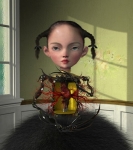Mar 24, 2005
Animator Makes Waves as Artist
From WIRED
by Rachel Metz
NEW YORK -- If beauty is in the eye of the beholder, oversized heads, alarmingly cherry-red lips, blotchy skin and sharp scroll-like claws are en vogue, at least in the digital world of artist Ray Caesar.
Caesar, a Toronto-based former animator and graphic artist for a children's hospital, is making waves in the world of pop art with his haunting, surreal digital prints, all produced just 18 months after he decided to pursue art full time. His works combine varied aspects of his life experiences, including the sorrow and inspiration brought by deaths of loved ones, and his years spent viewing photos of and working with abused, neglected and deformed children. His prints also benefit from Caesar's expertise with animation software and his exposure to animal research.

The prints are both grotesque and beautiful. As Caesar explains it, it's like facing something unpleasant with calm and looking beyond what you're viewing to see the beauty within.
Exhibits of Caesar's work are as real as it gets, because his art is created and manipulated digitally on his Dell 8300 computer and then printed on his massive, wide-format Epson 7600 printer. The "original" exists only on Caesar's hard drive and can be repositioned and changed at his whim. He uses the animation program Maya to compose his pieces.

A selection of Caesar's works were presented Saturday March 19, at the evening opening of his latest show, Hidden Doors and Secret Rooms, at the Jonathan LeVine Gallery in New York City's Chelsea neighborhood.
The show, which runs through April 18, had an impressive opening for an artist so new to his field. Throngs of curious visitors milled around, chatting and viewing pieces showcasing Caesar's signature haunted style.
To craft his prints, Caesar makes a digital doll model with an invisible inner skeleton. He can then pose the dolls or refine parts of their skeletons.
He embellishes the blank models with clothing he builds in Maya. At home in Toronto, Caesar visits a textile warehouse where he borrows swatches or buys yards of fabrics that strike his fancy. He then photographs the cloth and manipulates it in Photoshop.
Similarly, Caesar collects skin images he shoots with a digital camera and then maneuvers them in Photoshop before applying the images as a model's epidermis.
Furniture designs are inspired by things like antiques, Richie Rich comics, and items that surrounded him in his childhood homes, first in England and later in Canada, he said.
Because of the way his pieces come together, "I kind of feel like I'm doing reverse animation," Caesar said, later explaining, "There's so much movement, and yet in I'm ending up with a still image."
Besides movement, Caesar is a fan of digital recycling -- anything he can reuse, he does, he said, like elements of an image of an airplane, sewing machine or distant building. He's also big on detail, as is evident in intricate tattoos, tiny table-top knickknacks and seemingly 3-D textures of subjects' dresses.
READ FULL ARTICLE
About the artist
Information about Ray Caesar can be found on the artist's official web site
12:50 Posted in Cyberart | Permalink | Comments (0)







The comments are closed.